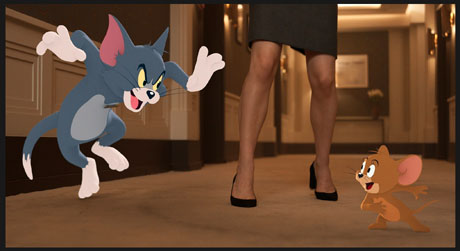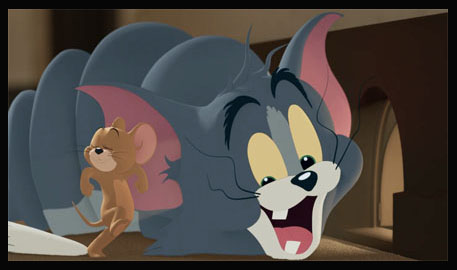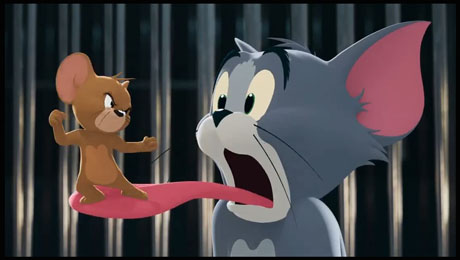
When MGM decided to revive their iconic animated stars Tom and Jerry in 1961, they entrusted Rembrandt Studios, located in Prague, Czechoslovakia, with the job. Director Gene Deitch reportedly showed his animation team six T&J cartoons and then put them to work. This weekend, in 2021, when this brand new hybrid feature film Tom & Jerry premiered, I found it difficult to believe that anyone working on the film had seen any Tom and Jerry shorts at all.
I reach this harsh conclusion because TJ is not really a Tom and Jerry film at all; The cat and mouse are actually incidental characters in a live-action film of tremendously stupid conception, featuring a plot that would have been embarrassing in a kid’s live-action TV production. This movie had been in production since 2009, and judging from the results, many people wasted 12 years of time, treasure, and studio good will. This is a film which completely fails to learn from the mistake of countless Tom and Jerry revivals and pays heavily for it.

First, however, a word about the animation. I must admit that Tom and Jerry look more like themselves than they have in all their years of uninspired revivals and direct-to-video abominations. The 2D animation is especially slick and allows the squash-and-stretch techniques common to some of the best 1940’s heyday of the T&J series as produced by Joe Barbera and Bill Hanna; Ken Muse, Ed Barge, and Irv Spence would have been impressed. Some of the incredible speed in the shorts (Tex Avery’s influence) is replicated in TJTM, and facial expressions are wonderfully flexible. This animation was provided by Framestore, a 3D animation outfit that used clever lighting effects to make the characters appear three dimensional while animating in 2D technique. And this highlights the film’s most serious, and ultimately fatal, problem.
The movie, if reports are correct, was originally conceived as a totally animated feature, and it would have been more successful if that version had been carried through. Anyone who has seen just a few more films than Gene Deitch and company did knows that the best T&J shorts featured no humans save for a pair of black (later white Irish) feminine legs and off-screen scolding voices. Many shorts did not even bother with those. The highlight of a T&J opus was unabashed mayhem, rapid-paced violence, and physical punishment that nothing made of flesh and blood could survive. This made attempts at extending the characters to full-length features difficult; Some converted the pair into buddies, which borders on blasphemy. Other attempts gave them voices, which compromised the characters’ very conception. TJTM makes yet another sort of mistake—scattering less than 15 total minutes of Tom vs. Jerry (much of it in the frentic first few scenes) throughout 101 minutes of a live action movie.
Oh, screenwriter Kevin Costello did some homework; Several characters from the classic series such as Spike the bulldog, Toots the seductive cat, and mean Butch and the alley cat gang show up, but none play any roles of consequence. It’s hard to believe that Costello was the only screenwriter over 12 years; the scattershot nature of the film (directed haphazardly by Tim Story, who was responsible for two awful Fantastic Four features) suggests multiple writers slinging their input around as well. For example, for the convenience of the plot, the event planner (Michael Pena) causes untold destruction when he could have simply let go of a dog’s leash.

And, oh, the human cast! The peeps are headed by Chloe Grace Moretz, are mostly disasters. Moretz is horribly miscast as Kayla, the millennial con artist who steals an honest applicant’s resume in order to obtain a highly paid job as a wedding planner at a premier hotel. She looks far too young and guileless for the part, and the makeup artists, hair stylists, and costumers do her no favors; throughout the movie she looks like a high school girl playing some undefined sort of professional in the senior class play. Her acting (when she can even spatially locate the animated characters) is no more professional than her appearance and would not fool anyone twice as stupid as the other live actors are written to be.
Moretz is also a victim of the awful script and directing: in the film’s denouement, she introduces the applicant whose resume she stole to the hotel director. Earlier in the film she cannot even remember the woman’s name, so how did she even find her? This contrived scene was put in only to redeem Kayla’s “good name” and is as awkward as anything else in the film. Moretz reportedly beat out 13 other contenders for the role. At twenty-four, Moretz has a bright future ahead but needs a serious talk with her agent.
Only Rob Delaney, as the unflappable hotel manager and Pallavi Sharda, as the Indian bride fated to be unhappily married in the Royal Gate Hotel, central location for the picture, show any life. Everyone else, including Ken Jeong, who overemotes every line, is easily replaceable. But enough of that; suffice it to say that nothing in the script, story, or plot works to the degree that a standard 1940s T&J short does.

Which brings us to the final lesson provided by Tom and Jerry: These animated characters are uniquely suited for one style of presentation only: animated shorts in which they are the clear protagonists. Adding other characters such as Spike (or Goldie the goldfish, who makes throwaway appearances in the movie) can work, as long as they are involved directly in the cat/mouse conflict) Not paying heed to that fact has resulted in countless direct-to-video features and copycat TV series that do not, and CAN NOT capture the spirit and elan of the classic shorts.
At the time of this writing, the movie is a critical and financial disappointment, opening at $39 million worldwide on an $80 million dollar budget. For classic animation fans, including myself, Tom and Jerry is a slap in the face, a ruinous take on the legend with hapless live actors running around in it and relegating Tom and Jerry to supporting characters in their own movie. Still, what can you expect from a film that opens with rapping pigeons who perform for no reason and then never appear again?
In closing, I warn future aspirants who wish to defile future projects involving Tom and Jerry by quoting the immortal words of a Ms. Dinah Two-Shoes: “Get out of here, you punk-nose ol’ messin’ good-for-nothin’! You know you are not allowed in this house—ever!”
- ANIME REVIEW: “Lonely Castle in the Mirror” - September 24, 2023
- REVIEW: “Teenage Mutant Ninja Turtles: Mutant Mayhem - August 15, 2023
- REVIEW: “Spider-Man: Across The Spider-Verse” - June 7, 2023


 March 1st, 2021
March 1st, 2021  Martin Goodman
Martin Goodman  Posted in
Posted in  Tags:
Tags: 






